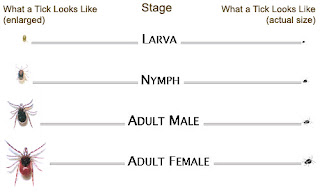Recently we've been hearing a lot about ticks and Lyme Disease and an increase of sightings in many parts of the country. So we've updated some information from a past article on the topic.
Bad year for ticks? What you need to know
 As
kids we all knew about dog ticks and there were several tricks we used
to rid our pets of them and keep them off but now there are several
other varieties and they can be much more dangerous. How can you avoid
them and what should you do if bitten?
As
kids we all knew about dog ticks and there were several tricks we used
to rid our pets of them and keep them off but now there are several
other varieties and they can be much more dangerous. How can you avoid
them and what should you do if bitten?Here are ten facts about ticks you may not know.
10. Ticks crawl up. They don't jump, fly or drop from trees onto your head and back. If you find one attached there, it most likely latched onto your foot or leg and crawled up over your entire body.
9. All ticks (including deer ticks) come in small, medium and large sizes.
8. Deer Ticks in particular are not killed by freezing temperatures and will be active any winter day that the ground is not snow-covered or frozen.
7. Ticks carry disease-causing microbes. Tick-transmitted infections are more common these days than in past decades. With explosive increases in deer populations, extending even into semi-urban areas in the eastern and western U.S., the trend is for increasing abundance and geographic spread of deer ticks and Lone Star ticks. Scientists are finding an ever-increasing list of disease-causing microbes transmitted by these ticks including Lyme disease bacteria, Babesia protozoa, Anaplasma, Ehrlichia, and other rickettsia, even encephalitis-causing viruses and possibly Bartonella bacteria. Back in the day, tick bites were more of an annoyance but now a bite is much more likely to make you sick.
6. Only deer ticks transmit Lyme disease bacteria. The only way to get Lyme disease is by being bitten by a deer tick or one of its "cousins" found around the world.
5. For most tick-borne diseases, you have at least 24 hours to find and remove a feeding tick before it transmits an infection. Even a quick daily tick check at bath or shower time can be helpful in finding and removing attached ticks before they can transmit an infection. Lyme disease bacteria take at least 24 hours to invade the tick's saliva.
 |
| courtesy of Global Lyme Alliance |
4. Deer tick nymphs look like a poppy seed on your skin.
And with about one out of four nymphal deer ticks carrying the Lyme
disease spirochete and other nasty germs in the northeastern,
mid-Atlantic, and upper mid-western U.S., it's important to know what
you're really looking for. They're easy to miss, their bites are
generally painless, and they have a habit of climbing up (under
clothing) and biting in hard-to-see places.
3. The easiest and safest way to remove a tick is with a pointy tweezer.
Using really pointy tweezers, it's possible to grab even the poppy-seed
sized nymphs right down next to the skin. The next step is to simply
pull the tick out like a splinter.
2. Clothing with built-in tick repellent is best for preventing tick bites.
An easy way to avoid tick bites and disease is to wear clothing (shoes,
socks, shorts or pants, and shirt) with a tick repellent built-in.
1. Tick bites and tick-borne diseases are completely preventable.
There's really only one way you get a tick-transmitted disease and
that's from a tick bite. Reducing tick abundance in your yard, wearing
tick repellent clothing every day, treating pets every month and getting
into a habit of doing a quick body scan are all great actions for
preventing tick bites. Some have suggested that bounce dryer sheets, especially in a pant
cuff or hanging out of a sock will waylay the little buggers. I've seen
it work with mosquitoes and ants: it's worth a try.
If you've been bitten: Time for Lyme, Inc. has compiled an
interesting list of things to consider if you've been bitten by a tick.
The list promotes caution but not fear. You can find it on the Global Lyme Alliance website.
Courtesy of www.tickencounter.org

This post may contain affiliate links, meaning I get a commission if you decide to make a purchase through my links. There is no additional cost to you. Full Affiliate Disclosure
 Teri Blaschke is the
RV Park operator of family owned HiddenValley RV Park in San Antonio, TX and writer of the park blog “A Little
Piece of Country in San Antonio.” Teri contributes to various other blogs with
a focus on either travel or social media and how it relates to the outdoor
hospitality industry but her passion is serving the RV travel community by
providing a memorable RV camping experience and growing the Hidden Valley RV
family. Connect with Teri on Google+, Facebook
and Twitter@HiddenValleyRV.
Teri Blaschke is the
RV Park operator of family owned HiddenValley RV Park in San Antonio, TX and writer of the park blog “A Little
Piece of Country in San Antonio.” Teri contributes to various other blogs with
a focus on either travel or social media and how it relates to the outdoor
hospitality industry but her passion is serving the RV travel community by
providing a memorable RV camping experience and growing the Hidden Valley RV
family. Connect with Teri on Google+, Facebook
and Twitter@HiddenValleyRV.
No comments:
Post a Comment